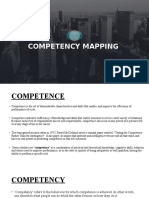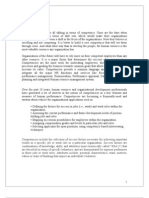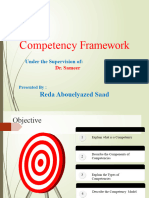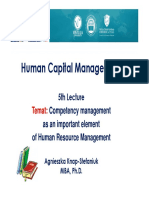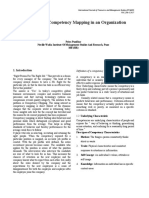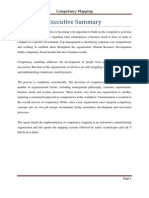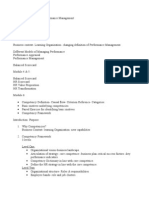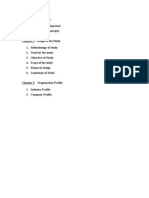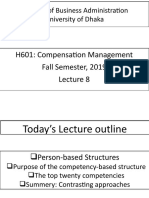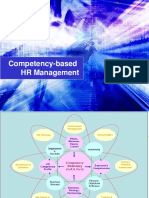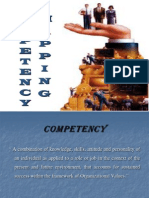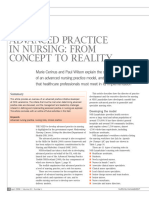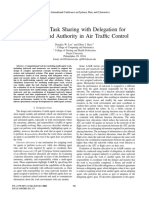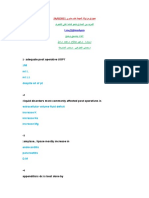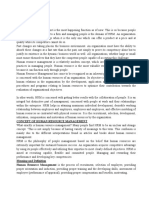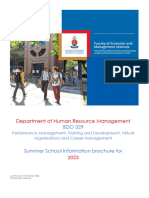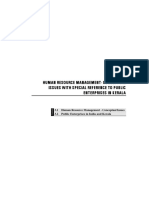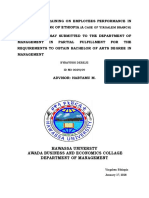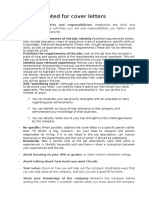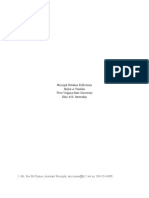Competency-Based
(Education, Training, and HR management)
Definitions:
Competence: describes ability people to perform a specific task or a job.
Competently – competence – an area of work.
Competency: describes how people behave when they carry out their jobs.
Competency – the behaviour(s) supporting an area of work.
Competences: describes what people need to be able to do to perform a job
well. Competencies – the attributes underpinning behaviour such as knowledge,
skill and attitudes.
Requirements of competency:
1. The requirement to perform individual tasks (task skills).
2. The requirement to manage a number of different tasks within the job (task
management skills).
3. The requirement to respond to irregularities and breakdowns in routine
(contingency management skills).
4. The requirement to deal with the responsibilities and expectations of the work
environment (job/role environment skills).
Components of competence: How are competencies acquired?
1.Knowledge including pre-service education, in-service training and continuing
education.
1
�2.Skills refer to ―actions that an individual performs in a competent way in order
to achieve a goal. Skills are gained by hands- on training using anatomic models
or real patients, or role plays.
3.Abilities refer to the power or capacity to do something. Abilities are gained or
developed over time.
4.Traits refer to distinguishing characteristics or qualities from one to another.
These include attitudes, personal and social values, self-control and self-
confidence.
Why healthcare organizations should measuring competence?
1. Healthcare reform: Healthcare organizations need to assess students and new
graduates and the continuing competence of experienced and certified
practitioners.
2. Organizational performance improvement: Healthcare organizations need to
assess organizational performance periodically to assess the efficacy of their
services.
3. Individual performance improvement: Healthcare organizations need to
assess individual performance that plays an important role in an organization’s
performance improvement.
4. Selection of new staff: Healthcare organizations need to assess recruiting new
staff to ensure they can do the well job.
5. Supervision: Healthcare organizations need to guide healthcare managers in
providing performance improvement feedback to healthcare providers.
2
� Factors that created new demands of competence on the field of
nursing:
1. The rapid changes of healthcare sector.
2. The changes of population structure.
3. The increase of diversity of work.
4. The new technologies of biomedicine.
5. The orientation toward the market.
Conceptual approaches to competency:
1. The behaviorist approach: The focus on doing to achieve an expected result
(behaviors).
2. The functionalist approach: The focus on what a person should be able to do
(tasks).
3. The constructivist approach: The focus on the combination of knowledge,
experience and behaviors (behaviors and tasks).
Benefits of competencies:
1. Selection: Focuses on distinguish between competencies that are trainable after
hiring and are more difficult to develop.
2. Training and development: Focuses to address missing competencies or gaps
in competency proficiency levels.
3. Performance management: Focuses about a person‘s behavior on the job and
performance outcomes.
4. Career paths: Focuses about promotion and long term career growth.
3
�5. Succession planning: Focuses on all of above, and curriculum development for
leadership development programs for management succession planning.
Characteristics of the competency
Characteristics Perspectives
1. Integrative Each competency requires many
different kinds of resources.
2. Combinatorial Each competency involves organizing
resources in various ways.
3. Developmental Each competency develops throughout
life (learning ongoing process).
4. Contextual Each competency is applied in
contexts that guide the action.
5. Evolutionary Each competency is designed to
integrate new resources and situations
without compromising its nature.
Types of the competency:
1.Individual competency – This type of competency refers to a person’s
knowledge, skills, and attitudes (behavior) that contribute to effectiveness in
performance.
oProblem solving.
oDecision making.
oCommunication.
oCommitment.
oCrisis management.
oHumor.
oEfficiency.
4
�2.Business competency – This type of competency refers to the knowledge and
skills required in a particular business.
oCustomer service.
oCommunication.
oJob ethics (Professionalism and integrity).
oAccountability and responsibility.
3.Management competency – This type of competency refers to the competencies
required for supervisory and managerial positions or roles (task-oriented).
oJudgment.
oRelationship building.
oResults orientation.
oStress tolerance.
4.Leadership competency – This type of competency refers to the competencies
required for leadership positions or roles (people-oriented).
oInfluence.
oResourcefulness (Shows creativity, takes initiative, and finds solutions).
oResults Orientation.
oCommitment.
5.Functional competencies– This type of competency is specific to a certain job.
oReporting.
oData analysis.
oTechnology.
5
�6.Core competencies– This type of competency refers to general competencies
specific to an organization.
oExcellent customer service.
oExpertise in electronic technology.
oSuperior market distribution skills.
General areas of competency:
1. Meaning competency: The person assessed must be able to identify the purpose
and values of the organization.
2. Relation competency: The person assessed must be able to create and nurture
connections to the stakeholders of the primary tasks.
3. Learning competency: The person assessed must be able to create and look for
situations that reflect on the experience.
4. Change competency: The person assessed must be able to act in new ways
within the organization.
Dimensions of the sustainable competence:
1. Knowledge and experience: The first dimension of competence is knowledge
and experience (The ability to solve a problem).
2. Personal capabilities: The second dimension of competence is personal
capabilities (The personal characteristics such as innovative and personal
capabilities such as professionalism).
3. Social capability: The third dimension of competence is social capability (The
ability to share knowledge and interact with others).
6
�4. Leadership qualities: The fourth dimension of competence is leadership
qualities (The people management skills, capability to lead a team in the right
direction, and ability to support others in their work).
5. Ability to learn: The fifth dimension of competence is ability to learn (The
capacity to take in and interpret new knowledge, ability to get information or
learning new things).
6. Ability to manage complexity: The last dimension of competence is the ability
to manage complexity (The capability to manage ambiguity and complex,
constantly changing situations).
Factors that have an impact on generating new competences
1. Organizational-level factors include interpersonal interactions, social context,
group learning, and heterogeneous environment.
2. Personal-level factors include attitude, problem solving, reflection, time to
learn, taking responsibility, and training.
Models of the competence
I.Model (1): Learning domains, Bloom's Taxonomy model (1956): The model has
three domains of competence are:
1. Cognition (knowledge‐based): the cognitive domain (Intellectual capability,
i.e. Knowledge, or 'Think'.
2. Affective (emotive‐based): Affective domain (Feelings, Emotions and
Behavior, i.e. Attitude, or 'Feel')
3. Psychomotor (action‐based): Psychomotor domain (Manual and Physical
Skills, i.e. Skills, or 'Do').
7
� II.Model (2): The "conscious competence" learning model (Noel Burch, 1970s).
The model has four stages of competence are:
1.Unconscious incompetence, when you don't know or why it would be important
to gain a new skill.
2.Conscious incompetence when you know that you are lacking a skill and
convinced it's important to treat this lack.
3.Conscious competence when you can do skills but it takes a lot concentrated
effort.
4.Unconscious competence when you so good to the skill, the individual may be
able to teach it to others professional performance.
III.Model (3): Miller [1990] suggested competence model that is helpful to show the
relation between educational programs and professional performance
(authenticity). The model has four levels of competence shown as the pyramid
of competence are:
1.At the first-lowest level of the pyramid the student has to (know) facts. ()
2.At the second level the student has to (know how) to apply facts. At the first and
second levels deal with cognition.
3.At the third level the student can (Show how) what he/she can do in a controlled
situation he can demonstrate.
4.At the fourth level the student performs (Dose) the tasks in reality. At the third
and fourth levels deal with skills and behavior.
8
� Competency-Based Education (CBE)
Definition:
Competency based education is an outcome focused approach that
concentrates on the mastery of skills at the learner‘s pace rather than within a
specific period of time.
Purposes of competency based education:
1. Measure student learning (progress) rather than time.
2. Harness the power of technology for teaching and learning.
3. Fundamentally change the faculty role.
4. Define competencies and develop valid, reliable assessments.
5. Prepare individuals for the challenges of the future.
Practical benefits of competency based education:
1. Greater understanding of learning outcomes.
2. Efficient and lower-cost degree options for students.
3. Motivated and engaged students.
4. Increased student retention and completion rates.
5. Learners’ improved ability to recognize and build their own competencies.
6. Employers’ improved ability to understand graduates’ competencies and
learning achievements.
7. Outcomes-based frameworks for continuous improvement at course, program,
and institutional level. " or continuance with our co
9
� Advantages (pros) of competency based education:
1.Relevant learning material.
2.Flexible learning process.
3.Suitable for adult learners.
4.Highly motivated, empowered, and confident students.
5.Students support and experience are provided.
6.Supports students with diverse backgrounds.
Disadvantages (cons) of competency based education:
1.Increased chances of procrastination among unenthusiastic students to learn.
2.Not suitable to future needs (more focused on developing skills that are needed at
present and less focused on developing skills that are needed at future).
3.Does not take social learning into account in a classroom (observation, imitation,
and modeling).
Attributes of competency based education:
The key attributes of competency-based teaching:
1. Measure student learning (progress) rather than time.
2. Understand how learners learn.
3. Match principles of learning and teaching.
4. Facilitate rather than control learning.
5. Support all learning domains (cognitive, psychomotor, and affective).
6. Critical thinking, respect, competency and caring at all times.
10
�7. Promote and except learner accountability for learning.
8. Provide timely and specific feedback on learner progress.
9. Individualize learning experiences according to needs.
10. Expect increasing complexity of performance as the learner progresses
throughout the program
The key attributes of competency-based learning:
1. Understand how one learns best (style).
2. Understand what an expected outcome of learning is.
3. Take responsibility for one’s learning.
4. Motivated to learn – goal oriented.
5. Ethical person and practitioner.
6. Critical thinker.
7. Self- learning assess & performance.
8. Commitment to ongoing learning.
Domains of teaching and learning required to CBE development.
A.Teaching and effective facilitation of CBE development.
Psychomotor domain:
1.Demonstrate the expected way to perform a given skill (demonstration skill).
2.Create a simulation exercise in the practical laboratory (repeated practice of
skills).
3.Create a valid and reliable assessment tool for determining competency in skill
demonstration.
11
� Affective domain:
1.Create clarification exercises for personal values.
2.Arrange for the discussion on different values and beliefs.
3.Create a valid and reliable assessment tool for determining competency in skill
demonstration.
Cognitive domain:
1.Develop case studies, discovery-based learning, and problem-based learning to
determine the most appropriate, evidenced based approach to competency.
2.Support learner-led discussions to address practical situations.
3.Avoid the temptation to answer every learner question.
B.Learning and effective facilitation of CBE development.
Psychomotor domain:
1.Review written description of a particular skill (text, handouts).
2.Take time for repeated practice of skills (mastery of the skill is demonstrated).
3.Seek out practical experiences that allow the learner to increase
confidence.
Affective domain:
1.Review text for content on definition of values.
2.Participate in selected clarification exercises for personal values provided by
teachers (self-study or group work).
3.Write up an analysis of a code of behavior and values, and share with peers and
teachers.
12
� Cognitive domain:
1.Competency-based learning requires high levels of critical thinking, discovery-
based learning, and problem-based learning.
2.Prepare for and lead seminar discussions.
3.Keep log of progress in learning.
Competency based assessment-clinical nursing
Definition
Clinical nursing competence: described as patient caring, communication,
coordination, management, teaching, and professional self- growth of student
nurses in clinical settings. Competency based assessment: A collection of
evidence to demonstrate that a learner can perform or behave according to
specific competency standards.
Stages of the clinical nursing competency:
Stage (1): Novice: Beginner with no experience in actual clinical situations.
Stage (2): Advanced Beginner: Has gained prior experience in actual clinical
situations.
Stage (3): Competent: Has gained 2-3 years’ experience on the job in actual
clinical situations.
Stage (4): Proficient: Learns from experiences what to expect and more holistic
understanding of clinical situations.
Stage (5): Expert: Much more background of experience and highly-proficient
of clinical situations.
13
� Requirements of competency based assessment
1. Focus on outcomes of learner’s performance.
2. Only two judgments can be made (Competent/Not yet competent judgment).
3. Assessment in workplace context under conditions as close as possible is
normally practiced.
Forms of competency based assessment
1. Diagnostic assessment: to diagnose areas of weakness and strength.
2. Formative assessment: to providing feedback about performance and progress.
3. Summative assessment: It is used when the learner feels confident of their
ability to perform in a work place (simulated environment).
Competencies essential to patient care
1.Health promotion competency: Refers the nurse‘s ability to promote and
improve health in individuals, families, and communities.
2.Supervision competency: Refers the nurse‘s ability to coordination and
implementation of a nursing care plans.
3.Interpersonal communication competency: Refers the nurse‘s ability to
communication, negotiating, problem solving, and collaboration.
4.Direct care competency: Refers the nurse‘s ability to deliver patient care
including medication administration, wound care, and injections.
5.Computer competency: Refers the nurse‘s ability to use electronic and
technological equipment to access, retrieve, and store information.
6.Caseload management competency: Refers the nurse‘s ability to coordinate
care for a specific number of clients.
14
� Competency Based-Training (CBT)
What is competency based training?
Competency-based training: Competency-based training: It is a training
approach to the attainment and demonstration of skills, knowledge and attitudes
to meet specified standards of performance.
Elements of competency-based training
1. Competencies to be achieved are carefully identified, verified and made public
in advance.
2. Criteria to be used in assessing achievement are explicitly stated and made
public in advance.
3. Assessment of competency takes knowledge and attitudes into account but
requires actual performance of competency as the primary source of evidence.
4. The instructional program provides for the individual development and
evaluation of each of the competencies specified.
5. Participants progress rate through the instructional program by demonstrating
the attainment of the specified competencies.
Characteristics of competency-based training
1. Competencies are carefully selected.
2. Supporting theory is integrated with skill practice.
3. Training materials are keyed to the competencies to be achieved.
4. Participants’ knowledge and skills are assessed as they enter the program.
15
�5. Methods of instruction involve mastery learning and include immediate and
comprehensive feedback to participants.
6. Flexible training approaches (large group, small group activities and individual
study).
7. A variety of support materials including print, audiovisual and simulations
(models) is used.
8. Learning should be self-paced.
9. Satisfactory completion of training is based on achievement of all specified
competencies.
Advantages of competency-based training
A.Advantages of competency based-training for employers:
1.Ensures that training activities are cost-effective, goal-oriented and productive.
2.Establishes a framework for constructive performance assessments at scheduled
intervals.
3.Improves communication between employees and management.
4.Improves quality of products and services.
5.Increases internal employee mobility and cross-training.
6.Outlines employee development and promotional paths within the organization.
7.Reduces cost caused by poor performance.
8.Standardizes performance across the organization.
9.Targets specific training needs.
16
�B.Advantages of competency based-training for employees:
1. Enables employees to be more proactive, engagement, and motivation by
learning additional skills.
2. Increases job satisfaction.
3. Offers a reference for day-to-day job requirements.
4. Provides a mechanism for the recognition of employees 'abilities.
5. Provides clear direction for learning new job skills.
6. Sets clear expectations for employees, enabling them to make better decisions
and work more effectively.
7. Ensures that individual professional development and training are recorded and
acknowledged by the organization.
C.Advantages of competency based training for participants:
1. Focus on the success of each participant.
2. Participants will achieve competencies required to do their jobs.
3. Participants receive a list of the competencies they have achieved.
4. Participants build confidence and master.
5. Training time is used more efficiently and effectively as the trainer as opposed
to a provider of information.
6. More training time is devoted to working with participants individually or small
groups as opposed to presenting lectures.
7. More training time is devoted to evaluating each participant‘s ability to perform
essential job skills.
17
� Disadvantages of competency-based training
1. Unless initial CBT and follow-up assistance is provided for the trainers, there is
a tendency to teach as role of the traditional teacher.
2. A CBT course is only as effective as the process used to identify the
competencies. When little or no attention is given to identification of the
essential job skills, it is likely that the resulting training course is ineffective.
3. Unless specific CBT materials and training approaches are designed to be used
as part of a CBT approach, it is unlikely that the resulting course will be truly
competency-based.
Implications for using competency-based training
1.Organizations must be committed to providing adequate training materials.
2.Audiovisual materials need to be directly related to the written materials.
3.Training activities need to match the objectives.
4.Continuous participant interaction and feedback must take place.
5.Trainers must be trained to conduct competency-based training courses.
6.Individuals attending training must be prepared for CBT.
18
� Competency-Based HR management
Definition:
Competence‐Based Human Resource Management (CBHRM) is an
application of HRM, which focuses more on the people competencies in regard
to their knowledge, skill, and attitude required to perform the jobs within an
organization.
Human resource management functions:
1. Permit the organization to attain its objectives by giving direction and support.
2. Provides the guidance and services that enable organizations to get things done
about people.
3. Play a primary role in the establishment of an environment that allows people to
the best use of their abilities and understand their potential.
4. HRM includes everything related to the process of acquiring the resource and its
use, development and maintenance.
Role of competency based HR management
1. Understanding and defining the talent needed and available to accomplish
organizational mission.
2. Addressing skills deficiencies.
3. Matching talent available to performance needs.
4. Matching the right people with the right skills to the right jobs.
5. Each is essential to aligning organizational capability to organizational mission.
19
� Dimensions/Elements/stages of CBHRM:
1. Recruitment and selection is the process of attracting and choosing individuals
based on competence qualifications to apply for any position within an
organization.
2. Training and development is the process of enhancing the skills, knowledge,
and attitudes for doing a certain job in an organization.
3. A reward system is the process of motivate employees to improve their
performance within an organization.
4. Performance appraisal is the process of evaluating an employees’ job,
characteristics, behaviors, traits, and performance outcomes within an
organization.
5. Career planning is the process of making a career choice, mapping the career
growth, and taking steps to improve personally and professionally.
Antecedents of competence‐based HR management:
1.Organizational factors:
oThe size and type of the organization (private or public).
oThe organizational culture.
oThe nature of the HRM department.
oThe number of employees.
2. Individual factors:
o The HR managers’ competence.
oThe top manager’s role, intention, and characteristics.
3.Human resources policy:
20
�o Human resource policies and HRM practice.
Consequence of competence‐based HR management:
1.Organizational outcomes: Improve organizational outcomes including quality of
health care, patient safety, and patient satisfaction.
2.Employee outcomes: Improve employee outcomes including employee
competence, motivation, retention, employee performance, and job satisfaction.
3.Financial outcomes: Improve financial outcomes including financial
empowerment.
How wills your organization (benefit) from CBHRM:
1.Productivity gains
oOrganizations improve employee’s efficiency.
oDesired organizational behaviors are documented.
oRequired skills, traits, and attributes for all positions are defined.
2. Grow, retain, and attract the right talent
oUnderstanding and define the talent needed and available.
oMaintain an optimal talent pool.
oDefine a skills road map, which empowers individuals to manage and achieve
their own development.
3.Improve performance
oIdentify gaps between requirements and capabilities.
oDefine expectations for employees.
21
�oSet behavioral targets to encourage employees to go beyond expectations.
Competency based HR management and its outcomes (significant
benefits)
1.Improved recruitment and selection practices.
2.Improved individual, organizational and career development programs.
3.Improved performance management processes.
4.Improved communication.
5. Positive performance outcomes.
o Linking individual competencies directly to the organization’s goals;
oDeveloping profiles for roles and matching with the responsibilities (tasks).
oAssisting with the hiring of individuals with unique competencies.
oAssisting organizations in the ranking of competencies for both compensation and
performance management.
The competence loop – A framework for efficient competence
management (the interaction between a project and its parent
organization)
The first part of the framework is based on the four mechanisms in the
competence loop:
1. Competence utilization: Is the mechanism for utilizing the existing
competences in accordance with the organization’s strategic goals through
resource management and formal training, and it is the interface between the
parent organization and the project.
22
�2. Competence accumulation: is the mechanism for creating or acquiring new
competences through the work in projects.
3. Competence assimilation: is the mechanism for assessing, interpreting, and
understanding new knowledge in relation to core competences and it is the
interface between the project and the parent organization.
4. Competence transformation is the mechanism for performing competence
planning and combining new and existing competences to identify competence
gaps, update the knowledge base in relation to core competences.
The second part of the framework is based on the organization’s learning
strategy.
1. Exploratory learning strategy can be seen as the organization’s ability to
generate new competences and interpret them,
2. Exploitative learning strategy can be seen as the organization’s ability to
combine newly generated competences with existing competences and utilize
the combined competences in new projects.
N.B: The learning strategies should be balanced between exploratory and
exploitative learning to make a long-term contribution to the competitive
advantage.
23


